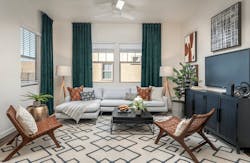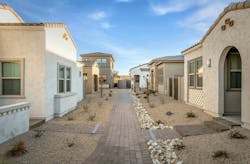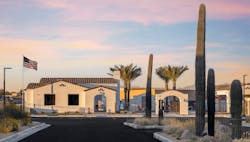Rich Eneim Jr., on Upgrading the Build-to-Rent Community Model
Not content to serve only the luxury production segment of the Phoenix market when he joined his father at Keystone Homes in 2008, Rich Eneim Jr., eventually landed on single-family build-to-rent (SFB2R) as the opportunity to counter the ups and downs of competitive high-end home building.
Since then, he has led the company’s development and construction of more than 520 SFB2R homes across four communities, starting with The Havenly in Fountain Hills, Ariz., a 147-unit project that won Gold in the 2022 Best in American Living Awards (BALA) for its innovative approach to site planning, varied elevations, and a diverse but cohesive mix of exterior finish materials that eschews the cookie-cutter look and feel of rental communities that preceded it.
PB: Why enter the build-to-rent segment?
Rich Eneim Jr.: Since my father started the company in 1989, Keystone Homes has built high-end first move-up for-sale production homes. When I joined the company in 2008, I strongly encouraged us to try to find some additional, more consistent revenue streams because you're always kind of chasing the next opportunity in the luxury production market.
We saw early iterations of the single-level build-to-rent concept and how successful those developers were and began studying their product and site planning. Quite frankly, the bar was pretty low in that space compared with the for-sale environment, but they were still having tremendous financial success.
We thought we could bring our brand of higher-quality design, construction, and land planning to that segment.
PB: What makes your approach different?
RE: We’re not looking at it just from an investment standpoint or commercial real estate, which I think is the lens some of the other developers use. We look at it as a single-family home.
We asked ourselves: What do people want when they buy a house?
It follows that they probably want the same things when they rent a house. So we’re being very thoughtful about the features we put into these homes.
We also kept all of the same principles that we apply in a for-sale environment, such as our commitment to energy efficiency. That may not help so much when you lease a home the first time, but it will certainly help when it comes to renewal because residents will have gained a sense and appreciation of their low energy bills, better comfort, and quietness, and they’ll want to stay there.
I think the incremental dollars investment we made into each house resonates so well with our residents. You get this sense of appreciation that I’d say is sometimes even higher than what you get from the buyer of a million-dollar home because most likely these renters are coming from an apartment or a single-family rental home that may have a one-off landlord where the level of service might be quite low.
We opened at 90% occupancy and had over 1,000 people on our interest list when we opened it, so it was received very well.
RELATED
- Read more about this build-to-rent community in our design feature about The Havenly
- Built to Rent Is Booming, But Operational Challenges Loom for This Housing Sector
- Maximizing Profits in the Build-to-Rent Space
PB: How did developing a rental community influence your land choices?
RE: We looked for land specifically for this concept. We wanted a transitioning piece that wrapped around a commercial retail corner and then transitioned to lower-density residential, and that's exactly what we found.
A prior developer had proposed a three-story assisted living project for the parcel, but it wasn’t received well. So when our project came through about two years later, we actually got applause at a public hearing. It was, and still is, the first time I've seen that happen.
It can be a little harder now to get the rezoning in place, but luckily we can rely on our track record and show that we're a little bit different, a bit more premium, and that's helpful.
PB: How did you define the program for The Havenly?
RE: We gave [the architect] Bassenian Lagoni a range of square footages for a mix of one-, two-, and three-bedroom homes within a high-density land plan.
Their approach was really a cluster concept, which is not new in a for-sale environment, but it was new for rental. It’s basically pods of six homes that use a benefit easement on the side yard, which ends up creating very private backyards for each home because they don't back up to each other.
It also increased the density, and I think improved the feel of the community.
PB: Bassenian Lagoni designed a mix of one- and two-story plans, as well as some diversity in elevations and materials. How was that different from what you saw in other build-to-rent communities in your market?
RE: A lot of the competing projects were kind of squatted down, really low, almost too horizontal, so we integrated about 15% of our homes to be two stories, which gives you a little bit more movement.
And without direct-access garages, especially on the front elevations, you can always make the house look a bit more interesting when you're not just staring at a big garage.
We also have walkways through some of the open space that connect the different clusters to one another. I think as you're walking down those pathways, it feels really nice just to look at all the different architecture.
PB: How do the site plan and house styles help create a sense of community?
RE: A sense of community is something we always talk about as developers, but it's very hard to actually achieve. With no direct-access garages, you actually create the opportunity for people walking to and from their homes to interact with one another and get to know one another.
The cluster concept also allowed us to orientate the front patios and porches to each other so each cluster shares a small park with grass and a bench for a little sense of community within the community.
And you know, once people start making friends in the community, it's kind of game over. They're gonna stay for a really long time.
PB: How did your trade partners respond to working on SFB2R homes?
RE: Our contractors actually love the idea of not having to accommodate options and changes and customizations in these homes. They can just show up and start and they don't even have to leave until the project's finished because they're not waiting for sales to fund the next phase before they can build more homes.
They get very excited about how fast we can go. We're starting six houses a week on these projects, so that, along with the uniqueness of the concept, I think everybody likes it. And, if anything, it keeps things more interesting and being able to do both for-sale and for-rent makes our team more versatile.
PB: Are you managing The Havenly or did you contract those services?
RE: We hired Cushman & Wakefield, which is a national property management company. They do a fantastic job for us and I think their level of service is a huge differentiator of this concept compared with renting a one-off house.
There's an on-site management team if you need A/C filters, light bulbs, or whatever, and they make it a very professional experience. That's not something in our expertise or something we would want to take on directly. And so it's a really, really good relationship to have.
RELATED
PB: You actually sold The Havenly. Why did Keystone sell it, who bought it, and have they maintained the vision you had for the community?
RE: We sold it to Pillar Properties, a private investment group out of Seattle. With it being our first rental community, it was a great opportunity to go full cycle and receive a great return on investment for our company and our investors. It also put us in a better position to capitalize the next three more Havenly-branded projects we had planned, which are all in active development and lease-up right now. And we'll continue to do more.
Pillar manages its communities and has a long track record of owning class-A properties for 10 or more years. They also deliver a high quality of customer service and attention to their residents, so we knew they were a good fit as a buyer to provide continuity to the existing residents.
PB: Is there anything else you learned from this B2R development that other builders interested in build-to-rent should know?
RE: Three things I would say: One, it's harder than it looks. Many people on our team have over 20 years of home building experience, and this was like a masterclass in residential development.
Two, it is key to incorporate the floor plan designs into the site planning phase. Others try to site plan with rectangles and kick the can down the road on floor plan designs, but they need to happen at the same time.
Three, it’s very invigorating to be innovating in a segment of the residential industry that is just getting started.




